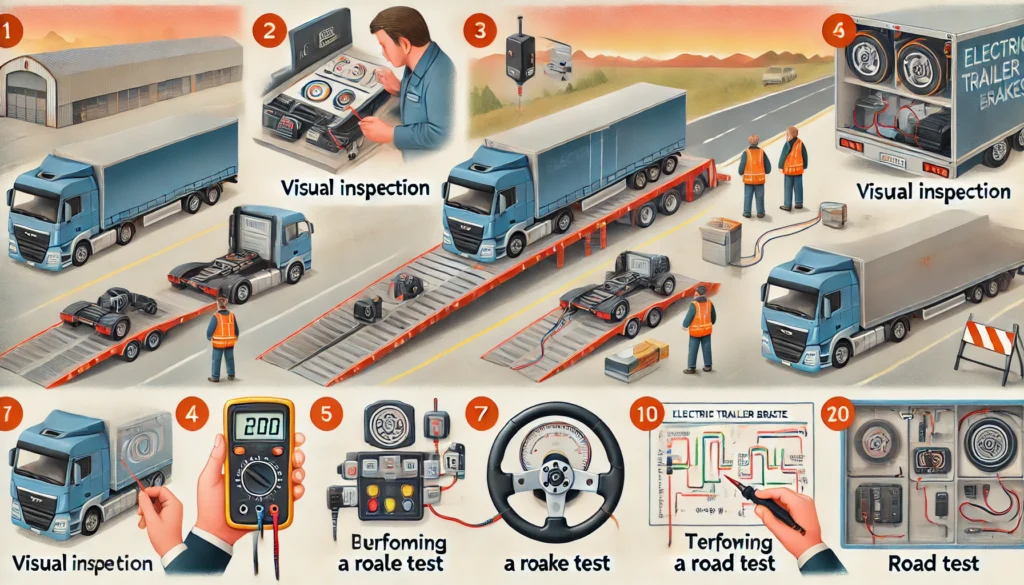Ensuring that your trailer’s braking system is functioning correctly is crucial for safe towing. But how do you test electric trailer brakes effectively? In this comprehensive guide, we’ll walk you through the steps to test your electric trailer brakes, ensuring they are working optimally before you hit the road.

Why Testing Electric Trailer Brakes Is Important
Before diving into the testing process, it’s important to understand why this step is necessary. Electric trailer brakes play a critical role in controlling your trailer, particularly when carrying heavy loads. Regular testing ensures that the brakes are responsive and reliable, preventing potential accidents caused by brake failure.
Step 1: Visual Inspection
Begin by performing a visual inspection of the brake system:
- Check the Wiring:
- Inspect the wiring leading to the brakes for any signs of wear, corrosion, or damage. Ensure all connections are secure and free from dirt or debris.
- Examine the Brake Drums and Shoes:
- Look for any signs of excessive wear or damage on the brake drums and shoes. If the shoes are worn down or the drums are scored, they may need replacement.
- Inspect the Brake Magnets:
- The brake magnets should be smooth and free from grooves or uneven wear. Damaged magnets can reduce braking efficiency.
Step 2: Testing with a Brake Controller
The brake controller in your towing vehicle is a key component in testing the brakes:
- Manual Override Test:
- Most brake controllers have a manual override feature. With the trailer connected, activate the manual override and observe if the trailer brakes engage. The trailer should stop or slow down depending on the level of force applied.
- Adjust the Sensitivity:
- Adjust the sensitivity settings on the brake controller and repeat the manual override test. The brakes should respond more or less aggressively depending on the setting.
- Monitor the Brake Controller Display:
- Some advanced brake controllers display diagnostic information, such as voltage output to the brakes. Ensure the voltage reading is within the recommended range for your trailer.
Step 3: Road Test
After performing the manual override test, it’s time to test the brakes under real driving conditions:
- Low-Speed Test:
- Drive your towing vehicle and trailer at a low speed (around 10-15 mph) in a safe, open area. Apply the brakes gradually and feel how the trailer responds. The braking should be smooth and proportional to the pressure applied.
- Higher Speed Test:
- Increase your speed to around 20-25 mph and repeat the braking test. The trailer should slow down smoothly without any jerking or pulling to one side.
- Emergency Stop Test:
- Simulate an emergency stop by applying the brakes quickly. The trailer brakes should engage immediately, helping to bring both the vehicle and trailer to a controlled stop.
Step 4: Testing with a Multimeter
To ensure that your electric trailer brakes are receiving the correct voltage, use a multimeter:
- Check the Voltage:
- With the trailer connected to the towing vehicle, set your multimeter to measure DC voltage. Probe the wires leading to the brake magnets while someone applies the brakes. The voltage should match the output specified by the brake controller (usually between 12-14 volts).
- Inspect the Resistance:
- Set the multimeter to measure resistance (ohms) and test the brake magnets. Compare the reading to the manufacturer’s specifications. A significantly higher or lower reading could indicate a problem with the magnets.
- Test for Continuity:
- Use the multimeter’s continuity setting to check for any breaks in the wiring. A continuous beep indicates the circuit is complete, while no sound suggests a broken wire or poor connection.
Conclusion
Regularly testing your electric trailer brakes is essential for safe towing. By following these steps, you can ensure that your brakes are functioning correctly and catch any potential issues before they become serious problems. Whether you’re preparing for a long trip or just a short haul, knowing how to test electric trailer brakes will give you the confidence that your trailer is under control.
